Thursday, October 20th, 2022
For Immediate Release
Sara Van Wormer Engages Students in Science and Engineering
During the 2022 Mass STEM Week “Extreme Zoo Makeover” Challenge
New Bedford, MA – Sara Van Wormer, Director of Education at Buttonwood Park Zoo, is a passionate science educator with experience conducting animal behavior research, teaching at a high school, and educating the public at zoos and aquariums. “Working with animals has got to be one of the most rewarding and challenging things that someone can do.” She notes that her coworkers at the Zoo include many incredible humans and amazing animals!
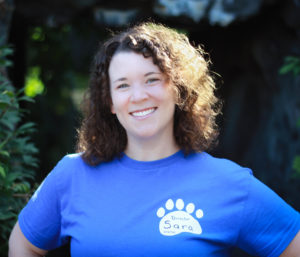
Photo courtesy of Sara Van Wormer, Buttonwood Park Zoo
Sara is currently collaborating with the Wade Institute for Science Education and the Lloyd Center for the Environment to hold the 2022 Mass STEM Week Challenge, “Extreme Zoo Makeover: A STEM Approach to Habitat Design.” The “Extreme Zoo Makeover” Challenge engages students in grades 5-8 in a unique experience that integrates science and engineering concepts in a series of inquiry-based investigations that lead up to a student-driven challenge. Students will be conducting background research to learn about animals, thinking critically about the animals’ needs in order to design enrichment activities that encourage natural animal behaviors, and engineering new habitats that enable animals to live naturally while also allowing zoo guests to view the magnificent creatures up-close.
Zoos allow people to have meaningful experiences with wildlife while still being protected by the designed safety precautions built into the habitats. “Almost everyone has been to a zoo or aquarium,” Sara says. “It’s important for people to have a connection to animals and to the biosphere. The ‘Extreme Zoo Makeover’ asks people to focus on the aspects of zoos and aquariums that make them uncomfortable and find solutions.” By designing habitats, students can help to make the lives of zoo animals more reminiscent of life in the wild. This is the Challenge that students must solve: “A Zoo has contacted your team of engineers because they want to do a makeover of some of their exhibits! As we learn more about animals’ needs, we’ve realized many Zoos’ habitats need a practical makeover to help serve those needs. You must find a way to 1) design habitats that meet the specific needs of the animals for which you are designing them, 2) engineer an enrichment item for your animal species that will stimulate natural behaviors, and 3) create an interpretive sign and interactive features that will engage the public in your animal habitat.”
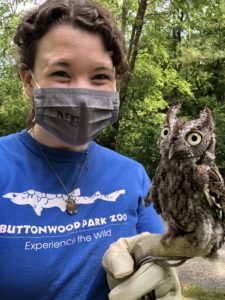
Sara shares Animal Ambassador Sherlock the Eastern Screech Owl
Photo courtesy of Sara Van Wormer, Buttonwood Park Zoo
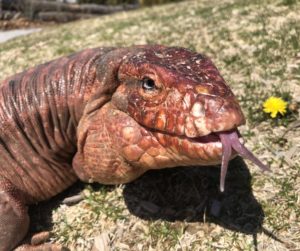
Animal Ambassador Roosevelt the Red Tegu
Photo courtesy of Sara Van Wormer, Buttonwood Park Zoo
What should students consider when designing their habitat? Sara says, “It is important to think of the animal’s needs (water, cleanliness, shelter, social interaction, etc) but when it comes to the challenge of designing a habitat, there is more that goes into it than the basics. You also need to consider the space from the perspective of the Animal Caretaker as well as the Zoo Guest.” Enrichment is also very important. Sara has been impressed with the scope of enrichment provided to animals at Buttonwood Park Zoo. She says one constant challenge of designing enrichment is to keep animals active and stimulated every day. Animals come to live at the zoo for various reasons and each has its own needs. These needs should be considered when engineering a habitat, enrichment programs, and designing signage to keep guests informed. “Animals’ stories can be complicated,” Sara says. “Context is important.” Zoos are hubs of conservation work where injured, orphaned, and endangered animals become ambassadors for their species as animal educators of the general public about habitat destruction and fragmentation, species loss, and human impacts on wildlife. It can be a challenge in itself to effectively convey each animals’ story. “Ideally, I’d love to have an education interpreter at each habitat,” Sara says, “to explain it all.”
Why do some zoos need a makeover? “There are different qualities of zoos and aquariums around the world. Buttonwood Park Zoo is Association of Zoos and Aquariums (AZA) accredited, which is the global gold standard.” Sara says. “This fun challenge provokes thoughts about why animals’ habitats matter so much.” The Challenge gets students to think critically about conservation issues occurring in their lifetimes and encourages problem solving through the exploration of new ideas. Sara says that she expects students “to come up with things that are really brave and original. These students might be the next habitat architects.”
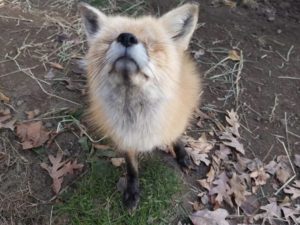
Animal Ambassador Piper the Red Fox
Photo courtesy of Sara Van Wormer, Buttonwood Park Zoo
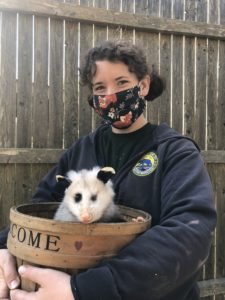
Sara shares Animal Ambassador Odin the Virginia Opossum
Photo courtesy of Sara Van Wormer, Buttonwood Park Zoo
Sara’s advice for anyone interested in working with wildlife is to “really value the journey, not just the destination” of your career. “Working with animals is an immensely rewarding experience,” she says. “A lot of times people want to snuggle monkeys or pet a tiger. It’s difficult but critically important to do what’s best for the animals, not necessarily what’s the most exciting or validating for us personally.” It takes compassion to continually do what is best for the animals, to correct misconceptions by speaking as a voice for animals that are misunderstood, and to inspire people to conserve local and global habitats by sharing the complex stories of animal ambassadors. “No conservation effort is too small,” Sara says. One of her favorite aspects of Buttonwood Park Zoo is that some of the animals there are findable in local habitats. “Everyone is a lifelong learner, and it’s important to remember that even what happens right here in our backyards matters. It is our obligation and ability to protect the planet.”
Educators who are participating in the “Extreme Zoo Makeover” Challenge met Sara at Buttonwood Park Zoo on September 17th, 2022, for a hands-on, interactive professional development session designed to engage them in the Challenge from the student perspective. On top of receiving a curriculum guide and a materials kit for implementing the Challenge with their students, educators designed and offered enrichment to Buttonwood Park Zoo’s coyotes, armadillo, river otters, and red panda. This experience was a real treat for all!
###
The Wade Institute for Science Education specializes in providing inquiry-based, hands-on, minds-on, science, technology and engineering professional development for K-12 teachers and informal educators. For more information, visit www.wadeinstitutema.org or call 617-328-1515.
